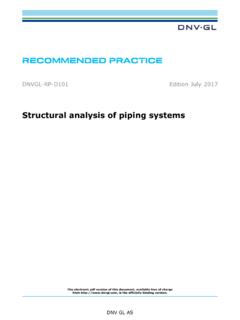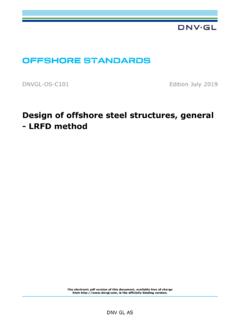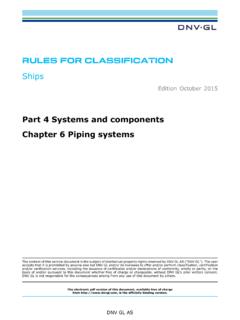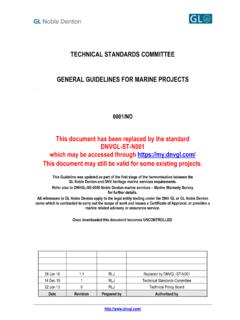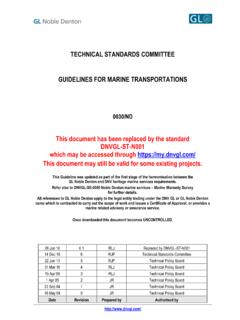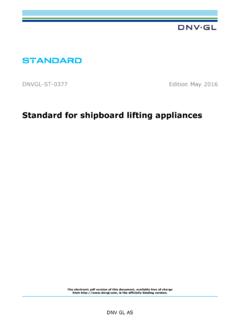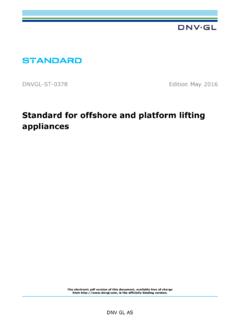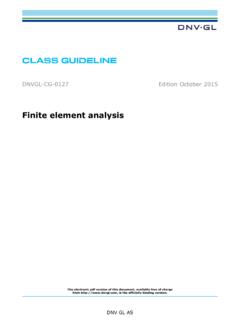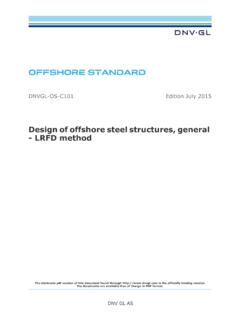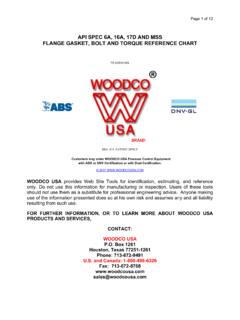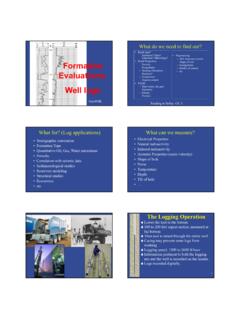Transcription of DNVGL-SE-0476 Offshore riser systems
1 The electronic pdf version of this document, available free of chargefrom , is the officially binding GL ASSERVICE SPECIFICATIONDNVGL-SE-0476 Edition August 2017 Offshore riser systemsFOREWORDDNV GL service specifications contain procedural requirements for obtaining and retainingcertificates and other conformity statements to the objects, personnel, organisations and/oroperations in question. DNV GL AS August 2017 Any comments may be sent by e-mail to service document has been prepared based on available knowledge, technology and/or information at the time of issuance of thisdocument. The use of this document by others than DNV GL is at the user's sole risk. DNV GL does not accept any liability or responsibilityfor loss or damages resulting from any use of this document. Changes - currentService specification DNVGL-SE-0476 . Edition August 2017 Page 3 Offshore riser systemsDNV GL ASCHANGES CURRENTG eneralThis document supersedes the October 2010 edition of purpose of the revision of this service document is to comply with the new DNV GL document reference code system and profile requirements following the merger between DNV and GL in 2013.
2 Changes mainly consist of updated company name and references to other documents within the DNV GL references in this service document may refer to documents in the DNV GL portfolio not yet published (planned published within 2017). In such cases please see the relevant legacy DNV or GL document. References to external documents (non-DNV GL) have not been correctionsIn addition to the above stated changes, editorial corrections may have been made. ContentsService specification DNVGL-SE-0476 . Edition August 2017 Page 4 Offshore riser systemsDNV GL ASCONTENTSC hanges 3 Section 1 Other 2 Technical Global Detailed component Structural reliability Special Fatigue Drilling, completion and Flexible risers and Material technology and failure Marine 3 Service Technical advisory Verification Certification Research and development A Applicable 51 Changes specification DNVGL-SE-0476 .
3 Edition August 2017 Page 5 Offshore riser systemsDNV GL ASSECTION 1 DNV GL provides various services related to dynamic riser systems , where the word dynamic isreferring to a non-stationary riser . In the notation dynamic riser systems , the following are included: metallic risers ( steel, titanium) composite risers flexible pipes umbilicals ( individual or piggy-back) loading The DNV GL services include technical advice/assistance (consultancy activities) researchand development services, in addition to more traditional design verification/product certification. Theverification and certification services are carried out with basis in rules, standards, regulations and This service specification (SE) provides criteria for and guidance to the above-mentioned services foreither complete dynamic riser systems , or for separate/self-contained components of riser DNV GL is a recognised provider of technical advisory services, which can be directly connected withthe development and design of deepwater riser For verification and certification, this service specification for dynamic riser systems aims at usingthe same principles/approaches as used in the service specification for submarine pipeline systems (DNVGL-SE-0475).
4 ObjectivesThe objectives of this document are to: describe DNV GL s overall competence and experience related to dynamic riser systems . describe DNV GL s technical advisory-, verification- and certification services for dynamic riser note:DNV GL will use this service specification as a reference document in writing bids/proposals to the clients. This will provide a clearand uniform understanding of the scope of work to be carried Organisation of this service This document consists of three sections and one appendix: This section; providing general scope of the present document, informative background information,definitions, abbreviations and references. ; providing information about DNV GL's competence, experience and technical approach used in theirdynamic riser services. ; providing information/specifications about DNV GL s services to dynamic riser systems . ; provides an overview of applicable software programs used by DNV specification DNVGL-SE-0476 .
5 Edition August 2017 Page 6 Offshore riser systemsDNV GL Structure of riser -related DNV GL Reference is made to the foreword to this document. From the document structure described therein,documents relating to riser systems consist of a three-level hierarchy with these main features: Principles and procedures related to DNV GL s services are separate from technical requirements and aredescribed in DNV GL service specifications. Technical requirements are issued as self-contained DNV GL standards. Associate product documents are issued as DNV GL recommended note:Product documents issued under previous document structures may be termed classification notes or The 3-level hierarchy is designed with these objectives: Service specifications present the scope and extent of DNV GL s services. DNV GL standards are issued as neutral technical standards to enable their use by national authorities, asinternational codes and as company or project specifications without reference to DNV GL s services.
6 The recommended practices convey DNV GL s interpretation of safe and sound engineering practice forgeneral use by the note:The latest revision of all official DNV GL publications may be found on the document list on the DNV GL s web site: DNV GL applicable standards and The following DNV GL standards and specifications relevant for dynamic risers apply (not limited to):Table 1-1 DNV GL Offshore rules and service specificationsReferencesTitleDNVGL-RU-OU -0101 Offshore drilling and support unitsDNVGL-RU-OU-0102 Floating production, storage and loading unitsDNVGL-SE-0475 Verification and certification of submarine pipelinesTable 1-2 DNV GL standardsReferencesTitleDNVGL-OS-C102 Structural design of Offshore shipsDNVGL-OS-C103 Structural design of column stabilised units - LRFD methodDNVGL-OS-C104 Structural design of self-elevating units - LRFD methodDNVGL-OS-C105 Structural design of TLPs - LRFD methodDNVGL-OS-C106 Structural design of deep draught floating units - LRFD methodDNVGL-OS-E101 Drilling plantDNVGL-OS-E201 Oil and gas processing systemsService specification DNVGL-SE-0476 .
7 Edition August 2017 Page 7 Offshore riser systemsDNV GL ASReferencesTitleDNVGL-ST-F101 Submarine pipeline systemsDNVGL-ST-F201 Dynamic risersTable 1-3 DNV GL recommended practice (RP)ReferencesTitleDNVGL-RP-A203 Technology qualificationDNVGL-RP-B401 Cathodic protection designDNVGL-RP-C203 Fatigue design of Offshore steel structuresDNVGL-RP-C205 Environmental conditions and environmental loadsDNVGL-RP-C211 Structural reliability analysis(replacing DNV Classification Notes No. )DNVGL-RP-C212 Offshore soil mechanics and and geotechnical engineering (replacing DNV Classification Notes No. )DNVGL-RP-F101 Corroded pipelinesDNVGL-RP-F105 Free spanning pipelinesDNVGL-RP-F106 Factory applied external pipeline coatings for corrosion controlDNVGL-RP-F113 Pipeline subsea repairDNVGL-RP-F203 riser interferenceDNVGL-RP-F204 riser fatigueDNVGL-RP-F205 Global performance analysis of deepwater floating structuresDNVGL-RP-N101 Risk management in marine and subsea operationsDNVGL-RP-O501 Managing sand production and erosionTable 1-4 DNV GL class guidelines (CG)ReferencesTitleDNVGL-CG-0051 Non-destructive testing(replacing DNV Classification Notes No.)
8 7)Table 1-5 DNV GL class programmesReferencesTitleDNVGL-CP-0338 Type approval schemeDNV GL class programmes for type approvalDNV GL class programmes for approval of manufacturersService specification DNVGL-SE-0476 . Edition August 2017 Page 8 Offshore riser systemsDNV GL The standard DNVGL-ST-F201 covers all aspects related to design and analysis of metallic andcomposite dynamic risers. DNVGL-ST-F201 is a result of the joint industry project Design Proceduresand Acceptance Criteria for Deepwater Risers. DNVGL-ST-F201 applies to all new-built all-metallic risersystems and may also be applied for modification, operation and upgrading of existing corresponding standard is applicable for both permanent operations ( production and export/import) as wellas temporary operations ( drilling and completion/workover). DNVGL-ST-F201 for dynamic risers iscompatible with DNVGL-ST-F101 for submarine pipeline systems .
9 The main benefits of DNVGL-ST-F201 are: consistent safety level flexible modern design principles (LRFD method, which is recommended for optimal design of deep waterriser systems ) cost effective design guidance and requirements for efficient global analyses allowance for use of innovative techniques and The DNV GL standards are subject to continuous development to reflect the state-of-the-artconsensus on accepted industry Other applicable standards and DNV GL services can be carried out by using our own standards and or specifications or any otherapplicable recognised standard or project specific specification and or Mixing of codes or standards for each system and equipment is in general to be avoided due to thepossible differences in safety philosophies. Deviations from the code must be specially noted and approved (ifnecessary).Guidance note:Most standards are a coherent collection of requirements for all the relevant aspects of a riser system.
10 These aspects, loadand resistance, are normally among themselves adjusted to give an overall acceptable safety level. To pick requirements fromdifferent standards can then easily result in unpredictable (low) levels of The following API publications are applicable to risers (not limited to):Table 1-6 API recommended practiceReferencesTitleAPI RP 2 RDDesign of Risers for Floating Production systems (FPSs) and Tension-Leg Platforms (TLPs)API RP 17 BRecommended Practice for Flexible PipeAPI RP 17 CRecommended Practice on TFL (Through Flow Line)API RP 17 IInstallation Guidelines for subsea UmbilicalsAPI RP 16 QRecommended Practice for Design, Selection, Operation and Maintenance of Marine Drilling RiserSystemsTable 1-7 API specificationsReferencesTitleAPI SPEC 17 JSpecification for Unbonded Flexible PipeAPI SPEC 17 GDesign and Operation of Completion Workover riser SystemsService specification DNVGL-SE-0476 .
